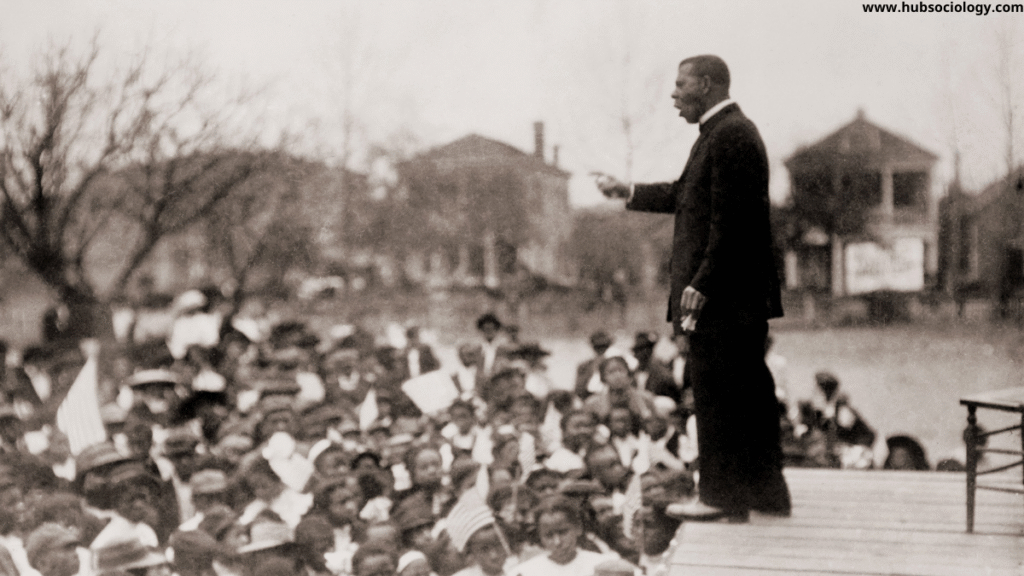Introduction
Society is a dynamic entity, constantly shaped by the interaction of individuals, groups and institutions. Social movements, the state, and civil society represent three crucial dimensions in this dynamic process. While social movements emerge from the grassroots to express demands, grievances, and aspirations of people, the state functions as a central authority that regulates and governs society. Civil society, on the other hand, acts as the bridge between the people and the state, providing a platform for associations, organizations, and collective action beyond the domain of government and market. The relationship between these three is a subject of deep sociological inquiry because it reflects the processes of change, conflict, negotiation, and transformation within society.
This article examines the interrelationship between social movements, state and civil society, highlighting their roles in shaping social change, democracy and social order.

Understanding Social Movements
In sociology, a social movement is defined as a collective, organized effort by a group of people to bring about or resist social change. Unlike temporary crowds or protests, social movements are sustained, ideologically motivated, and oriented toward larger transformations in society. Charles Tilly, Alain Touraine, and Anthony Giddens have emphasized that social movements are not only about protest but also about constructing new meanings, identities, and social relations.
Key Features of Social Movements:
- Collective Action – Social movements involve groups of people acting together with a shared purpose.
- Organizational Structure – They often develop leadership, strategies, and networks to mobilize resources.
- Ideological Basis – Movements rely on values, beliefs, and visions for social change.
- Target of Change – Movements can be reformist (seeking change within existing structures) or revolutionary (challenging entire systems).
- Sustained Nature – Unlike riots or crowds, social movements persist over time.
Examples include the Civil Rights Movement in the United States, the Indian Independence Movement, the women’s rights movement, environmental movements like Fridays for Future, and farmers’ protests across the world.
The State in Sociological Perspective
The state is a political institution that holds the monopoly over legitimate use of force, as famously defined by Max Weber. It represents authority, law, and governance. From a sociological standpoint, the state is not merely a neutral actor but a social relation, influenced by power, class interests, and historical conditions.
- Pluralist Perspective – The state acts as an arbiter balancing competing interests of different groups within society.
- Marxist Perspective – The state is an instrument of the ruling class, serving capitalist interests by suppressing workers and legitimizing inequality.
- Weberian Perspective – The state is a rational-legal authority that organizes society through bureaucratic structures.
- Postmodern Views – The state is seen as fragmented, where power is dispersed among multiple institutions, including global actors and transnational bodies.
In relation to social movements, the state often functions as both a target (of demands, protests, resistance) and an actor (that responds through policies, repression, or accommodation).

Civil Society: The Mediating Space
The term civil society refers to the sphere of social life that exists between the state and the market. It includes voluntary associations, NGOs, unions, professional organizations, community groups, religious institutions, and media. Thinkers like Alexis de Tocqueville and Antonio Gramsci have highlighted civil society as an essential arena where people organize to defend their rights and shape political discourse.
- Liberal View: Civil society is the bedrock of democracy, ensuring citizen participation and accountability.
- Gramscian View: Civil society is a site of ideological struggle where ruling class hegemony is maintained but also challenged.
- Contemporary View: Civil society functions globally, with transnational NGOs and movements influencing international governance (e.g., climate action, human rights).
Civil society thus provides the institutional and cultural space for social movements to thrive and to negotiate with the state.
Interrelationship Between Social Movement, State and Civil Society
The relationship among these three is dynamic and often marked by tension, cooperation, and negotiation.
- Social Movements and the State:
- Social movements often emerge in opposition to state policies, laws, or structures of domination.
- The state may respond by suppressing them (through police, laws, censorship), co-opting them (incorporating demands into policies), or accommodating them (granting reforms).
- For example, the civil rights movement in the U.S. forced the state to enact the Civil Rights Act of 1964.
- Social Movements and Civil Society:
- Civil society provides the organizational base and legitimacy for movements.
- Trade unions, NGOs, and student bodies often mobilize resources, awareness, and participation for social causes.
- For instance, environmental NGOs support grassroots environmental movements by lobbying, research, and international advocacy.
- Civil Society and the State:
- Civil society holds the state accountable through advocacy, media campaigns, and watchdog organizations.
- At the same time, the state regulates civil society by setting legal frameworks, registration rules, and restrictions.
- A strong civil society is seen as a hallmark of democracy, but authoritarian regimes often curb its autonomy.
Sociological Theories on the Triangular Relationship
- Resource Mobilization Theory:
Social movements succeed when they mobilize resources (money, people, organization). Civil society is crucial here as it supplies networks and legitimacy, while the state is both an obstacle and a resource to be influenced. - New Social Movement Theory:
Unlike older class-based movements, new social movements focus on identity, culture, and lifestyle (e.g., feminist, environmental, LGBTQ+ movements). They often operate within civil society and seek recognition rather than just material gains. - Conflict Theory:
Inspired by Marx, it emphasizes the struggle between oppressed and ruling classes. The state protects ruling interests, while movements and civil society become instruments of resistance. - Habermas’ Public Sphere:
Jurgen Habermas highlights civil society as a public sphere where citizens engage in rational debate to influence the state. Social movements play a vital role in expanding and democratizing this sphere.
Contemporary Examples
- Arab Spring (2010–2012): A series of uprisings in the Middle East where social movements, fueled by civil society groups and social media, challenged authoritarian states.
- India’s Anti-Corruption Movement (2011): Mobilized by civil society organizations and activists like Anna Hazare, it pressured the state to pass the Lokpal Bill.
- Black Lives Matter (USA): A movement that emerged from civil society and grassroots activism, forcing the state to address racial injustice and police violence.
- Climate Justice Movements: Transnational in nature, supported by civil society groups like Greenpeace, challenging states to adopt sustainable policies.
Challenges in the Relationship
- State Repression: Arrests, censorship, surveillance, and violence against activists.
- Co-option: States may neutralize movements by partially accepting demands but diluting radical agendas.
- Fragmentation of Civil Society: Not all civil society organizations are progressive; some may promote exclusionary ideologies (e.g., religious fundamentalist groups).
- Globalization: Transnational corporations and international institutions influence both civil society and the state, complicating local movements.
Conclusion on social movements, state and civil society
The relationship between social movements, state and civil society is a dynamic triangle shaping the course of social transformation. While social movements articulate the demands of marginalized and oppressed groups, the state represents the institutional power that can either suppress or respond to these demands. Civil society provides the mediating ground where collective identities are formed, resources are mobilized, and discourses are shaped. From a sociological perspective, the study of this relationship is crucial to understanding how societies negotiate change, conflict, and democracy.

In the contemporary world, with rapid globalization, technological advances, and rising inequalities, the interaction among these three domains has become more complex. Social movements now transcend national boundaries, civil societies are both empowered and restricted, and states face challenges from both below (grassroots demands) and above (global institutions). The vitality of democracy, justice, and social progress ultimately depends on how this triangular relationship evolves and sustains balance in society.
Do you like this this Article ? You Can follow as on :-
Facebook – https://www.facebook.com/hubsociology
Whatsapp Channel – https://whatsapp.com/channel/0029Vb6D8vGKWEKpJpu5QP0O
Gmail – hubsociology@gmail.com
Exam-style questions on social movements, state and civil society
5 Marks Questions on social movements, state and civil society (Short Answer)
- Define state and civil society from a sociological perspective.
- Differentiate between the functions of the state and civil society.
- Write a short note on the role of civil society in democracy.
- Explain how state and civil society interact during social movements.
- Give one contemporary example of the relationship between state and civil society.
10 Marks Questions on social movements, state and civil society (Medium Answer)
- Discuss the theoretical perspectives of state and civil society in sociology.
- Examine the role of civil society organizations in influencing state policies.
- “The relationship between state and civil society is both cooperative and conflictual.” Discuss with examples.
- How does globalization impact the relationship between state and civil society?
- Evaluate the role of civil society as a mediator between citizens and the state.
15 Marks Questions on social movements, state and civil society (Long Answer/Essay Type)
- Critically analyze the relationship between social movements, state and civil society with suitable examples.
- Compare the Marxist and Liberal views on state and civil society.
- “Civil society is the foundation of democratic governance, while the state represents authority.” Discuss in sociological terms.
- Examine the challenges and limitations faced by civil society in maintaining autonomy against state control.
- Assess the importance of state and civil society in shaping social transformation in contemporary societies.
